7 Multi Channel Marketing Campaign Examples to Inspire in 2025
August 7, 2025

In marketing, "multi-channel" is more than just a buzzword; it's the blueprint for creating seamless, resonant, and unforgettable brand experiences. It’s the art and science of meeting your audience where they are, weaving a consistent narrative across every touchpoint, from an Instagram ad to an in-store display. The goal isn't just to be present on multiple platforms, but to make each channel work in concert with the others, creating a cohesive journey that feels both personal and powerful. This approach transforms disjointed interactions into a unified brand story.
This article moves beyond theory to provide a deep dive into brilliant multi channel marketing campaign examples. We will dissect the strategies behind iconic campaigns from brands like Disney, Nike, and Starbucks, revealing the specific tactics they used to capture attention and drive results. You won't find surface-level summaries here. Instead, you'll get a strategic breakdown of their goals, channel mix, creative execution, and measurable outcomes. Each example is curated to give you actionable takeaways and replicable methods that you can adapt for your own marketing efforts. Get ready to explore the masterworks of modern marketing and find inspiration for your next breakthrough campaign.
1. Disney's Frozen II Multi-Channel Campaign
Disney's campaign for Frozen II stands as a masterful example of a multi-channel marketing campaign, demonstrating how to build and sustain global excitement. The strategy wasn't just about placing ads everywhere; it was about creating an interconnected world where each channel reinforced the others, guiding the audience from initial awareness to ultimate conversion at the box office and beyond. By weaving a consistent narrative and visual identity across diverse platforms, Disney transformed a movie release into a worldwide cultural event.
The core of this success was a deep understanding of each channel's unique strengths. Instead of generic, one-size-fits-all content, Disney tailored its messaging to fit the platform and its audience. This approach ensures that every touchpoint feels native and engaging, rather than intrusive.
Strategic Channel Integration
Disney orchestrated a symphony of marketing efforts that seamlessly blended digital and traditional media. This created an omnipresent yet non-repetitive brand experience.
- Social Media & Digital Content: On platforms like TikTok, Disney sparked user-generated content with dance challenges set to the movie's hit songs. YouTube was leveraged for a behind-the-scenes series, offering fans an exclusive look into the animation process and deepening their connection to the story.
- Retail Partnerships: A crucial element was the exclusive merchandise line with Target. This created in-store events and a "treasure hunt" atmosphere for fans, turning a shopping trip into an extension of the Frozen experience.
- Experiential & Mobile Marketing: The campaign extended into mobile gaming, integrating new movie storylines into existing apps. This tactic kept the brand top-of-mind and provided an interactive way for audiences to engage with the characters before the film's release.
This infographic summarizes the immense scale and strategic planning behind the campaign.
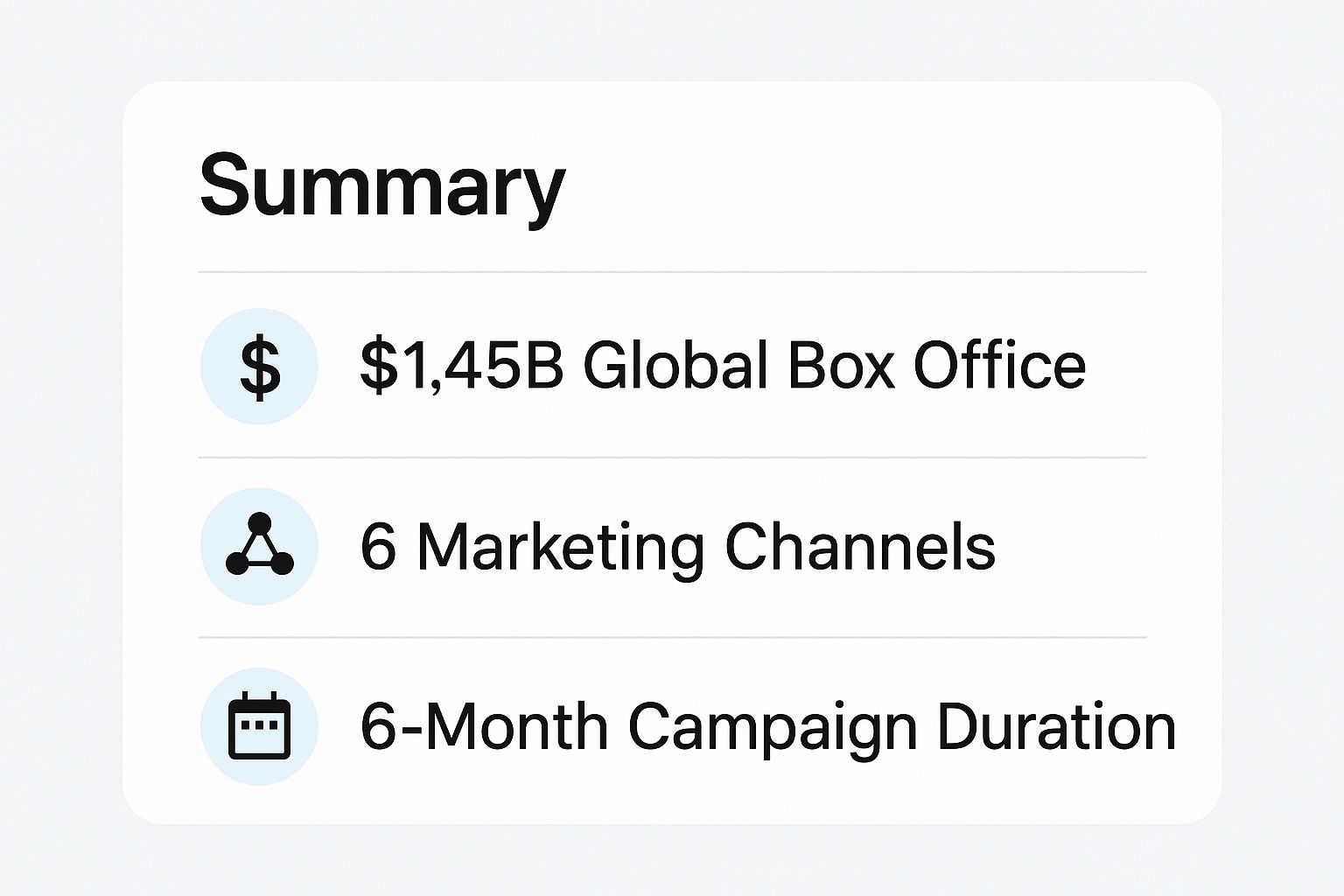
The data clearly illustrates how a well-coordinated, multi-channel effort over an extended period can translate into massive commercial success.
Key Takeaways
The Frozen II campaign offers powerful, replicable lessons for any brand aiming to make a significant impact.
Key Strategy: The campaign’s genius lies in its unified yet customized approach. Every piece of content, from a TV commercial to a TikTok video, felt like part of the same magical world while being perfectly optimized for its specific platform.
This meticulous coordination is a core principle for companies looking to build powerful brand awareness in a crowded marketplace. By ensuring consistent branding and staggered, strategic releases across channels, Disney maximized anticipation and drove record-breaking engagement.
2. Starbucks Rewards Multi-Channel Loyalty Program
Starbucks has transformed customer loyalty into a science, creating one of the most successful multi channel marketing campaign examples in modern retail. Its Rewards program is a masterclass in integrating digital and physical experiences to drive retention and increase customer lifetime value. The program’s brilliance lies in making every interaction, whether in-app, online, or in-store, feel like part of a cohesive and personalized journey. By unifying customer data across all touchpoints, Starbucks fosters a powerful sense of recognition and reward that keeps customers coming back.
The foundation of this strategy is a seamless user experience, where technology enhances rather than complicates the coffee-buying process. Starbucks understood that convenience is king, and built a system where digital tools like mobile ordering and payment are perfectly synchronized with the in-store experience. This creates a frictionless loop of engagement and purchasing.
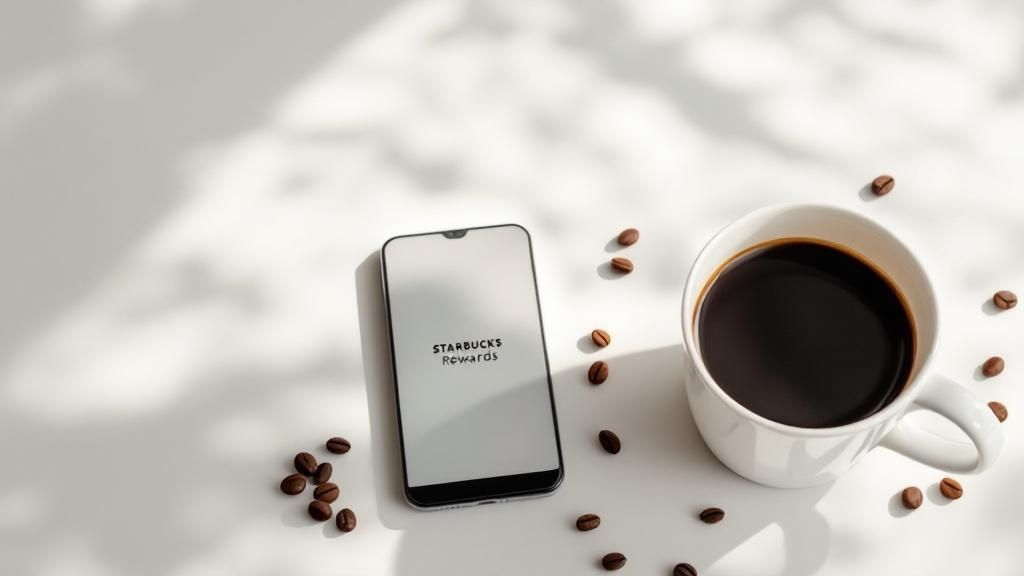
This interconnected ecosystem ensures that the brand remains top-of-mind, turning routine purchases into rewarding interactions.
Strategic Channel Integration
Starbucks orchestrates its channels to create a constant stream of engagement, making the Rewards program an indispensable part of the customer's daily routine. Each channel plays a specific role, yet they all work in harmony.
- Mobile App & Gamification: The app is the central hub, using gamification like "Double Star Days" and personalized challenges to encourage frequent visits. It also facilitates frictionless mobile ordering and payment, directly linking convenience with loyalty.
- Email Marketing: Starbucks uses email to deliver personalized offers, birthday rewards, and announcements about seasonal products. These emails often drive users back to the app or into a physical store to redeem a special deal, closing the loop between digital communication and physical sales.
- In-Store Experience: Physical locations are a critical channel. Baristas are trained to promote the Rewards program and assist customers with the app, ensuring that the digital initiatives are supported by human interaction. In-store signage consistently reinforces app-exclusive offers and seasonal campaigns.
This tight integration makes it simple for customers to engage with the brand on their preferred platform, at any time.
Key Takeaways
The Starbucks Rewards program provides a powerful blueprint for any business aiming to build lasting customer loyalty through a multi-channel approach.
Key Strategy: The campaign’s success hinges on its data-driven personalization. By leveraging purchase history and app behavior, Starbucks delivers hyper-relevant offers that make customers feel uniquely valued, which in turn drives predictable, repeat business.
This focus on tailored experiences highlights the importance of data in any modern campaign. Understanding how to connect actions to outcomes is vital, which is why brands must learn how to measure marketing effectiveness to replicate this level of success. By ensuring every channel contributes to a single customer view, Starbucks has built an engine for sustainable growth.
3. Nike's Air Jordan Multi-Channel Launch Strategy
Nike’s launch strategy for its Air Jordan line is one of the most sophisticated multi-channel marketing campaign examples in modern retail. The brand masterfully blends exclusivity, hype, and broad-reach storytelling to turn sneaker releases into global cultural moments. Instead of just selling a product, Nike creates a narrative-driven experience where each channel plays a specific role in building anticipation and driving demand, culminating in a frenzied, high-conversion launch day.
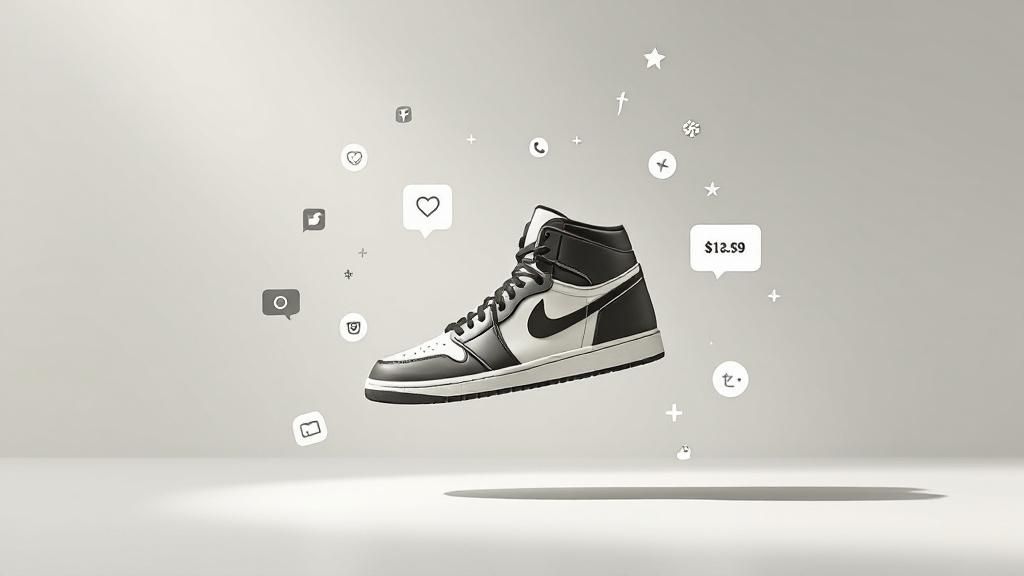
The foundation of this strategy is a deep understanding of its audience and the cultural capital the Air Jordan brand holds. Nike leverages this by making each release feel like an exclusive event, carefully orchestrating content reveals and access points across its ecosystem. This ensures the campaign feels both personal to the dedicated sneakerhead and aspirational to the mainstream consumer.
Strategic Channel Integration
Nike's approach creates an omnipresent yet highly coveted brand presence by synchronizing digital and physical touchpoints to perfection.
- Social Media & Influencer Hype: The campaign often begins on Instagram and X (formerly Twitter), where official images are "leaked" or revealed. High-profile collaborators like Travis Scott or Virgil Abloh then use their platforms to showcase the product, sparking massive organic conversation and user-generated content.
- Exclusive Digital Drops: The SNKRS app is the heart of the launch. Nike uses it for countdowns, behind-the-scenes stories about the shoe's design, and exclusive mobile-only raffles. This gamified approach creates urgency and transforms the buying process into a competitive event.
- Retail Partnerships & Experiential Events: Tiered releases are distributed through select retail partners and pop-up events, such as during NBA All-Star Weekend. These physical activations provide another layer of exclusivity and connect the brand directly with local sneaker communities. The timing of these drops is perfectly coordinated with the digital campaign.
For a deeper dive into how leading brands structure their campaigns, consider reviewing various social media marketing plan sample breakdowns, including those from companies like Nike.
Key Takeaways
The Air Jordan launch model provides a powerful blueprint for creating product hype and managing demand in any industry.
Key Strategy: Nike’s genius is in its controlled orchestration of scarcity and access. By using different channels to offer staggered information and varied purchasing opportunities, it maximizes desire while ensuring the brand story reaches a massive audience.
This carefully planned coordination is a testament to the power of a well-defined marketing channel strategy. By making each touchpoint part of a larger, cohesive narrative, Nike doesn't just sell shoes; it sells a piece of culture.
4. Coca-Cola's Share a Coke Campaign
Coca-Cola's "Share a Coke" campaign is a legendary case study in multi-channel marketing, demonstrating the immense power of personalization at scale. The campaign brilliantly tapped into the fundamental human desire for connection and recognition by replacing its iconic logo with popular names. This simple yet profound shift transformed a mass-produced product into a personal invitation, creating a global phenomenon that drove sales and unparalleled brand engagement.
The core of this strategy was making the customer the hero of the story. Instead of just broadcasting a message, Coca-Cola created a platform for personal expression and sharing. The campaign seamlessly merged the physical and digital worlds, encouraging people to find bottles with their names (or the names of friends and family) and share those moments online, turning consumers into active brand ambassadors.
Strategic Channel Integration
Coca-Cola masterfully orchestrated a campaign where every channel played a specific role in building momentum and encouraging participation. This created a cohesive and interactive experience that felt both global in scale and deeply personal.
- Retail & In-Store Marketing: The campaign began on the shelf. Eye-catching retail displays and point-of-sale materials turned store aisles into a treasure hunt, sparking curiosity and driving impulse purchases as shoppers searched for specific names.
- Social Media & User-Generated Content: This was the campaign's digital engine. The hashtag #ShareACoke exploded on platforms like Instagram, Facebook, and Twitter, as users proudly posted photos of their personalized bottles. Coca-Cola then amplified this user-generated content, making it a central part of its official marketing.
- Digital & Experiential Activation: The campaign extended online with a website allowing users to create virtual personalized bottles and share them. In many regions, touring kiosks and vending machines were set up to let people print custom labels on the spot, creating memorable real-world experiences.
Key Takeaways
The "Share a Coke" campaign provides a powerful blueprint for how to build an emotional connection with consumers and ignite organic, widespread engagement.
Key Strategy: The campaign’s success was rooted in its fusion of mass personalization with an inherently shareable concept. By making the product a vehicle for personal connection and social interaction, Coca-Cola created a powerful feedback loop where physical products drove digital conversations, which in turn drove more sales.
This approach highlights how a creative, customer-centric idea can be amplified across multiple channels. For brands aiming to foster loyalty, the lesson is clear: design experiences that don't just speak to your audience, but invite them to participate and share their own stories.
5. Sephora's Beauty Insider Multi-Channel Experience
Sephora’s Beauty Insider program is a gold standard in retail loyalty, transforming the simple act of purchasing cosmetics into a deeply integrated, multi-channel experience. The campaign’s brilliance is not just in rewarding purchases, but in building a cohesive ecosystem where every touchpoint, from the mobile app to the physical store, works together. By connecting online and offline worlds, Sephora creates a seamless journey that feels personalized, exclusive, and genuinely helpful.
The foundation of this strategy is using technology to solve real customer problems and enhance the shopping experience. Instead of treating channels as separate silos, Sephora views them as interconnected parts of a single customer relationship. This unified approach makes every interaction, whether digital or in-person, a valuable part of the brand journey.
Strategic Channel Integration
Sephora masterfully blends its channels to create a high-touch, personalized experience that drives both loyalty and sales. The program makes customers feel understood and valued, no matter how they choose to shop.
- In-Store Technology: The Color IQ service scans a customer’s skin to find their precise shade, which is then saved to their Beauty Insider profile. This data syncs across the app and website, making future online purchases for foundation and concealer foolproof.
- Mobile App & AR: The "Virtual Artist" feature within the app uses augmented reality to let users "try on" thousands of makeup products digitally. This bridges the gap between online browsing and the in-store trial experience, reducing purchase friction.
- Community & Social Proof: The online Beauty Insider Community acts as a dedicated social hub where members share looks, write reviews, and ask questions. This user-generated content provides authentic social proof and deepens engagement with the brand and its products.
This integration turns a simple loyalty program into one of the most effective multi-channel marketing campaign examples in the retail industry.
Key Takeaways
The Beauty Insider program demonstrates how to build a powerful community and drive repeat business by creating a truly customer-centric experience.
Key Strategy: Sephora’s success comes from using technology not for its own sake, but to create a seamless bridge between the physical and digital worlds. Every feature is designed to add value, solve a problem, or enhance the customer's journey with the brand.
This focus on creating a unified brand dialogue is crucial. By delivering consistent, valuable interactions across all platforms, Sephora ensures its core message resonates powerfully with its audience, a principle that is fundamental when you build a B2B messaging framework that works. The program’s design empowers customers, making them active participants in the brand story.
6. Old Spice's The Man Your Man Could Smell Like Campaign
Old Spice’s "The Man Your Man Could Smell Like" campaign is a legendary multi-channel marketing campaign example that demonstrates how to revive a legacy brand for a new generation. The strategy was not just about a clever TV spot; it was about creating a cultural moment by building a two-way conversation with its audience. By seamlessly connecting a traditional broadcast launch with groundbreaking, real-time digital engagement, Old Spice transformed its brand perception from dated to dynamic and hugely relevant.
The core of this success was its ability to bridge the gap between passive viewing and active participation. Instead of letting the conversation die after the commercial aired, Old Spice used the initial broadcast as a launchpad for a deeper, more personalized interaction online. This approach proved that a great creative concept could be magnified exponentially when adapted brilliantly across different channels.
Strategic Channel Integration
Old Spice’s team, led by agency Wieden+Kennedy, executed a masterful plan that turned a one-way message into a viral phenomenon. This created an unforgettable and highly participatory brand experience.
- Broadcast Television: The campaign kicked off with a now-iconic TV commercial featuring Isaiah Mustafa. Premiering during high-profile events, it served as the "anchor content," establishing the unique tone, humor, and personality that would define the entire campaign.
- Real-Time Social Media Response: The true genius was the follow-up "Response Campaign." The team monitored social media platforms like Twitter and Facebook for comments and questions directed at the Old Spice Man. They then filmed and uploaded over 180 personalized video responses on YouTube in just a few days.
- YouTube & Digital Content: The brand’s YouTube channel became the central hub for the personalized video responses. This tactic not only rewarded engaged fans but also generated an enormous amount of new, shareable content that kept the campaign trending for days.
This fusion of mass media with personalized digital interaction created a powerful feedback loop, making audiences feel seen and heard.
Key Takeaways
The Old Spice campaign provides a powerful blueprint for leveraging humor and real-time engagement to capture widespread attention and affection.
Key Strategy: The campaign’s brilliance lies in its rapid and personalized content creation infrastructure. By treating a TV commercial as the start of a conversation, not the end, Old Spice was able to create a dynamic and interactive experience that felt personal to millions.
This approach is a masterclass in how brands can use humor and personality to stand out. By preparing to react and engage in real-time, Old Spice didn’t just market a product; it created a pop culture icon and fundamentally changed the rules of digital advertising.
7. Airbnb's Belong Anywhere Multi-Channel Storytelling
Airbnb's "Belong Anywhere" campaign is a landmark example of how to use multi-channel marketing to fundamentally shift brand perception. The strategy moved Airbnb from being seen as just a budget alternative to hotels to a global community offering unique, authentic travel experiences. By placing real human stories at its core, the campaign created a powerful emotional connection that resonated across every touchpoint.
The success of "Belong Anywhere" came from its commitment to authentic storytelling. Instead of polished ads, Airbnb featured real hosts and guests, showcasing their genuine interactions and unique spaces. This user-centric approach allowed the brand's message to feel personal and trustworthy, regardless of the channel.
Strategic Channel Integration
Airbnb masterfully blended its channels to tell a consistent, emotionally driven story of community and belonging. Each platform was used to highlight a different facet of the travel experience, creating a rich and immersive brand world.
- Broadcast & TV: The campaign launched with TV commercials that felt like mini-documentaries, featuring real families and their travels. This high-reach channel established the core "Belong Anywhere" message on a massive scale.
- Social Media & User-Generated Content: On Instagram, Airbnb curated a stunning visual feed of unique properties and travel moments, largely sourced from its community. This turned its social presence into a living, breathing testament to its brand promise, powered by its users.
- Email & Host Community Engagement: Airbnb nurtured its host community through targeted email marketing and dedicated online forums. By empowering hosts to share their own stories and tips, the company cultivated an army of brand advocates who amplified the campaign's message organically. In addition to its storytelling, Airbnb's strategy also stems from compelling referral marketing campaigns, showcasing how advocacy can fuel multi-channel growth.
Key Takeaways
The "Belong Anywhere" campaign demonstrates how emotional, story-driven content can build a brand that transcends its product. It offers a clear blueprint for companies wanting to build a loyal community.
Key Strategy: The campaign’s brilliance lies in its use of authentic, user-generated stories to create a unified brand identity. By making its community the hero, Airbnb built an emotional moat that competitors found impossible to cross.
This community-first approach is central to B2B strategies as well; to see other examples, you can learn more about powerful demand generation campaigns. By turning customers into storytellers, brands can generate a level of trust and loyalty that traditional advertising simply cannot buy.
Multi-Channel Marketing Campaigns: 7 Case Comparison

Your Blueprint for Multi-Channel Success: From Inspiration to Implementation
We've journeyed through some of the most iconic multi channel marketing campaign examples in modern history, from the immersive world-building of Disney's Frozen II to the viral genius of Old Spice. The campaigns from Starbucks, Nike, Coca-Cola, Sephora, and Airbnb each offer a masterclass in strategic integration, proving that the whole is truly greater than the sum of its parts. These titans of industry didn't just throw content at every available platform; they wove a consistent, compelling narrative that met their audience exactly where they were, with a message that felt both personal and universal.
The common thread connecting these successes isn't a secret formula but a set of core principles. They all began with a profound understanding of their audience, allowing them to craft a single, powerful core message that could be adapted-not just copied-across diverse channels. This adaptability is key; a tweet’s sharp wit is different from a loyalty app’s personalized offer, which is different from a cinematic television ad. Success lies in making each touchpoint feel native to its platform while reinforcing the central campaign idea.
Distilling the Core Principles for Your Strategy
As you move from inspiration to implementation, it's crucial to distill the essential takeaways from these powerful examples. The difference between a scattered, ineffective effort and a resonant, high-impact campaign often comes down to a few foundational pillars.
Here are the most critical lessons to build your own multi-channel blueprint upon:
- Unified Brand Story: Don't just run ads; tell a story. Whether it's Coca-Cola’s message of connection or Airbnb’s theme of belonging, a cohesive narrative ties every channel together into a singular, memorable experience.
- Channel-Specific Adaptation: Treat each channel as unique. Nike's exclusive sneaker drops on the SNKRS app created urgency and exclusivity, a tactic that wouldn't work the same way on a billboard. Tailor your creative and your call to action to fit the context of the platform and the user's mindset.
- Data-Driven Personalization: Leverage customer data to create meaningful interactions. Sephora’s Beauty Insider program and Starbucks Rewards excel because they use purchase history and user behavior to deliver offers and content that feel genuinely valuable and personal.
- Engagement Over Interruption: The most successful campaigns invite participation. Old Spice and Coca-Cola created interactive experiences that encouraged user-generated content, transforming passive viewers into active brand advocates. As you plan your next move, consider how emerging formats can deepen this engagement. To further inspire your multi-channel strategy and discover innovative approaches for 2025, explore these 8 interactive video examples for inspiration.
Mastering a multi-channel approach is no longer a luxury for B2B and B2C brands; it's a fundamental requirement for cutting through the noise and building lasting customer relationships. The examples we’ve explored demonstrate that a well-executed strategy does more than just boost sales-it builds brand equity, fosters loyalty, and creates a cultural footprint. By applying these principles, you can begin crafting your own campaigns that don't just reach your audience, but truly resonate with them.
Ready to architect a high-impact multi-channel strategy that drives real growth for your tech or B2B startup? At Big Moves Marketing, we specialize in building the integrated marketing engines that turn ambitious goals into measurable results. Visit Big Moves Marketing to see how we can help you build your own legendary campaign.
%20-%20Alternate.svg)
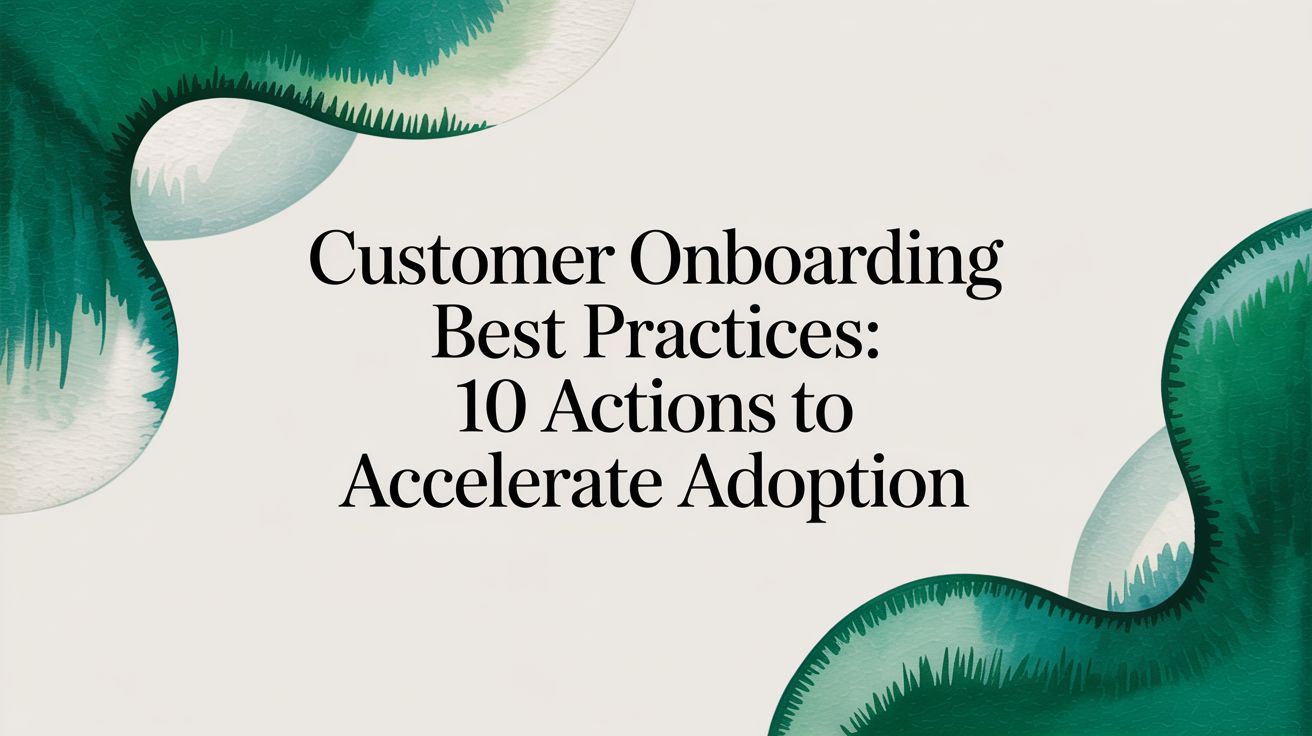
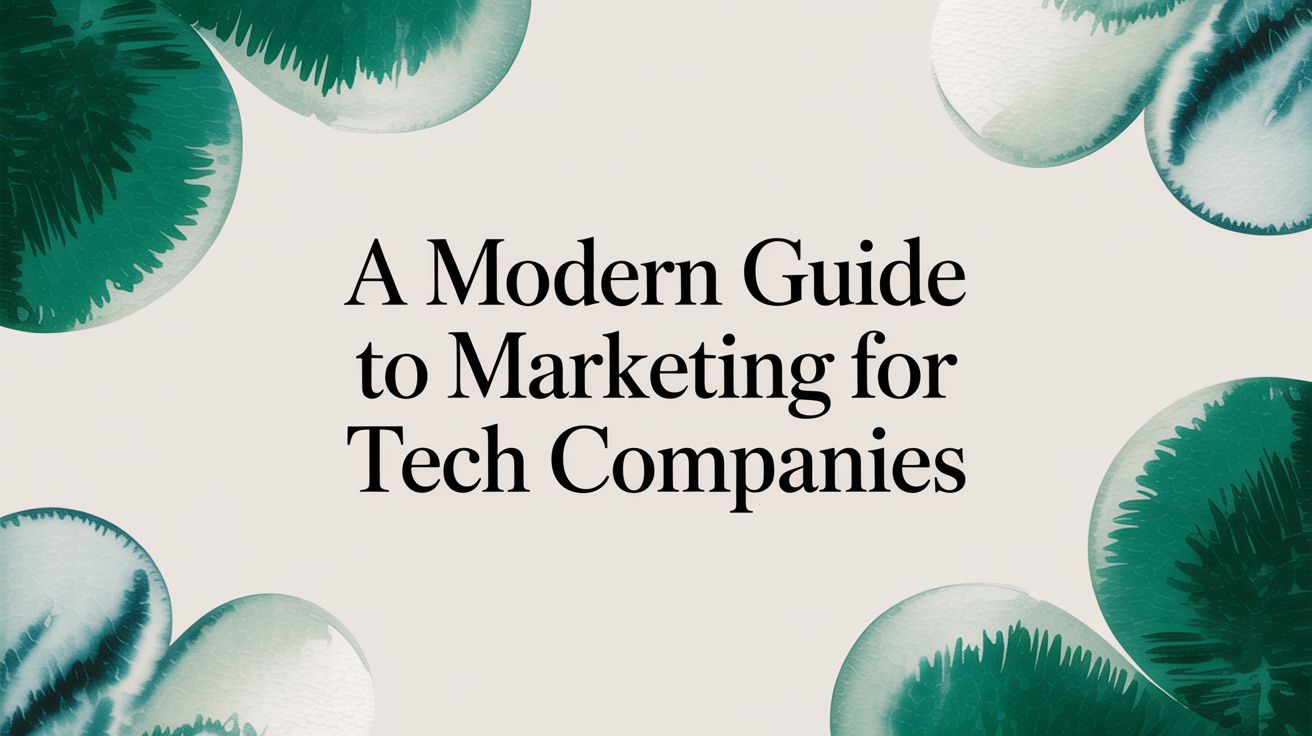
%20-%20white.svg)